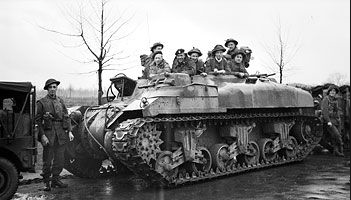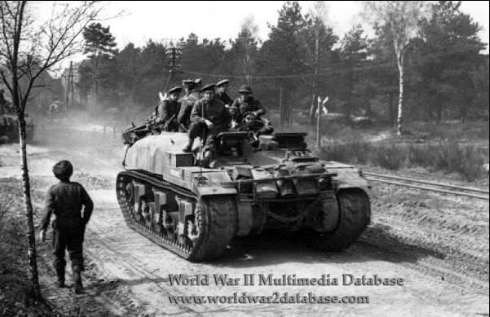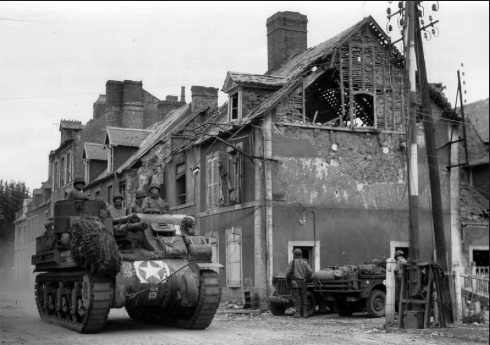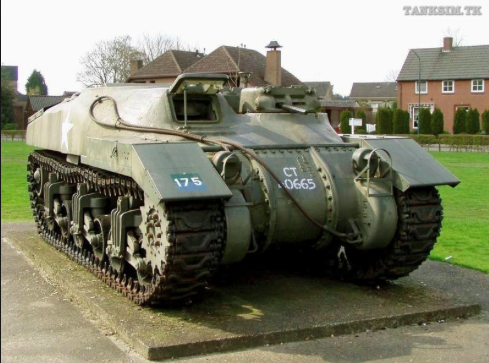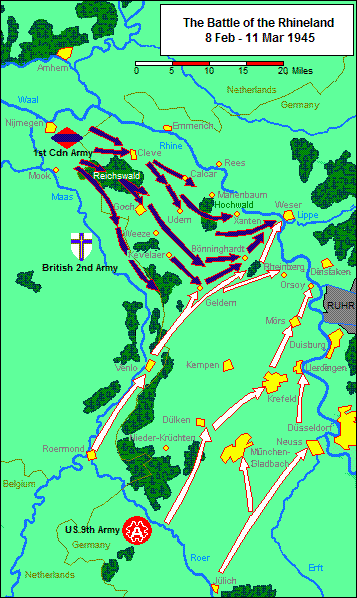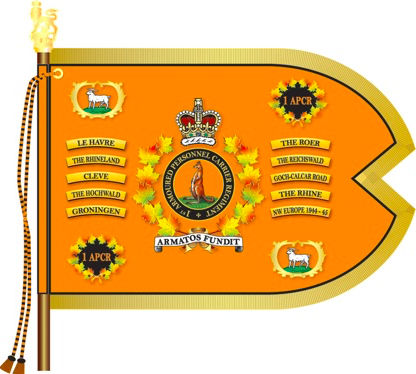Trooper Russell Frederick Gerry, whose name is on the Strathroy cenotaph, was a member of this Regiment.
The 1st Canadian Armoured Carrier Regiment was unique in the history of the Canadian Army in that it was unit formed on foreign soil and disbanded on foreign soil.
During the Battle of Normandy the requirement for a tracked armoured fighting vehicle to transport personnel over long distances, protected from enemy small arms fire and shrapnel, made itself apparent. In preparation for Operation TOTALIZE in August 1944, Lieutenant General G.G. Simonds, commander of II Canadian Corps, ordered the conversion of US M7 Priest self-propelled guns into the Kangaroo armoured personnel carrier. The vehicles were modified and the crews were trained, and their first use during the Falaise Gap battles were successful. A Kangaroo Squadron was organized on 26 August 1944, attached to the 25th Canadian Armoured Delivery Regiment (The Elgin Regiment) for administrative purposes. Both the Elgins and the Kangaroo Squadron were army-level assets of 1st Canadian Army. The second in command of the Elgins, G.M. Churchill, took command of the squadron in the rank of Lieutenant Colonel.
The Squadron was employed against Le Havre on 2 September 1944, carrying British soldiers of the 51st (Highland) Division, followed by actions at Boulogne (17 Sept) and Calais (25 Sept). At Le Havre, only one infantry casualty was suffered and these actions were again deemed successful. At Calais, a Canadian Kangaroo driver rammed a German Tiger tank, capturing it and later receiving a Military Medal for the act.
When the modified M7 Priests were returned to the U.S. Army (they had been on loan for the Normandy Landing), modified Ram tanks were introduced into service. They were issued at Rouen, and the squadron organized with 16 Ram Kangaroos for each of its four troops. The Squadron moved to The Netherlands, coming under command of the British 2nd Army. The Squadron went into action at ‘s-Hertogenbosch on 23 October 1944, followed by other actions at Schilburg, St.Michiels-gestel, Boxtel, Esch, Moergestel, Tilburg, Kaatsheuvel, Waspik, Waspik-Boven, Raamsdonk and Laan. In the first two months of its existence the Squadron carried out 30 operational lifts.
(This image is a scale model from a company which is now out of business)
In the meantime, 21st Army Group had been so impressed by the Kangaroo Squadron’s ability to deploy infantry that two entire regiments of Kangaroos were authorized, one for each Army under command. On 24 October 1944, 1st Canadian Army authorized the formation of the 1st Canadian Armoured Personnel Carrier Regiment, and Kanagaroo Squadron at Tilburg was used as a cadre for the expansion. During the operational lull as 1st Canadian Army wintered in the Nijmegen Salient, the regiment expanded to two squadrons, each with 53 Ram Kangaroos divided into four troops. In December 1944, the Regiment was taken from 1st Canadian Army and, with the British 49th Armoured Carrier Regiment, attached directly to British 79th Armoured Division. The Regiment was also renamed, as Lieutenant Colonel Churchill felt that “Personnel” would imply the regiment was part of the Royal Canadian Army Service Corps rather than the Canadian Armoured Corps, and so a new name was approved taking effect 1 December 1944: 1st Canadian Armoured Carrier Regiment.1
The Regiment went into action in January 1945 in the province of Limburg, assisting in a variety of assaults on Susteren, Baakenhoven, Dieteren, Oud Roosteren, Echt, Schilberg, Koningsbosch, Steaten, Erpen, and the German towns of Uetterath, Dremmen and Heinsberg.
In February 1945, the Regiment saw action in The Rhineland during Operation VERITABLE, (*) taking part on attacks on Kranenburg, Frasselt, Schottheide, Bresserberg, Kleve, Moyland, Hasselt, the road to Veen and Xanten. After a short rest, the regiment participated in Operation PLUNDER in Mar 1945, becoming the first Canadian armoured regiment to cross the River Rhine on 26 March 1945, and participating in attacks on the Dutch towns of Millingen, Megchelen, Landfort, Ruurlo, Borculo, Barchem, Lochem, Haarle, Assen, Hooghalen, Rolde, Balloo, Loon and Groningen. The last lift of the war was made on German soil on 5 May 1945, near Oldenburg.
(*) Editor’s note: It was on February 9th, 1945, while the Kangaroos were attached to the British 79th Armoured Regiment, that trooper Russell Gerry of Strathroy – Caradoc and two of his crew were killed.]
The Regiment concentrated at Penheim, Germany and at 23:59hrs on 20 June 1945 the Regiment disbanded.
During their brief existence, the Regiment lost 17 men killed and 71 wounded and conveyed soldiers from 38 separate British infantry regiments and 20 Canadian infantry regiments into battle.
[Source: Canadian Soldiers]
Other links:
“1st Canadian Armoured Carrier Regiment” (Wikipedia)
“1st Armoured Personnel Carrier Regiment” (Canadian Soldier)
“The Kangaroo” (Canada at War)
“Kangaroos at War the History of . . .” (Canadian Military History)
“Canadian Kangaroos” – a 2011 interview with a veteran of the regiment (Canadian Interviews)
“Kangaroo Armoured Personnel Carrier” (Perth regiment)
The images can be viewed at Google

